
Scan our QR code to stay updated with the recent news and upcoming events.
03.11-05.28.2023
No.288 Shi Men Yi Road, Unit W01, Jingan District, 200002 Shanghai, China
“Feel the Power” Group Exhibition by Female Artists
Exhibition Duration: March 11th, 2023 – May 28th, 2023
Artist: Bai Shui, Chen Zhou Ya Yi, KeySook Geum, Lin Fanglu, Sabrina J, Ye Hongxing
Curator: Zirui Zhuang
Venue: HKRI Taikoo Hui
No.288 Shi Men Yi Road, Unit W01, Jingan District, 200002 Shanghai, China
Mon-Sun, 10:00 am -10:00 pm
ABOUT THE EXHIBITION
The Reborn of Goddess
by Zirui Zhuang
Imagine a vast, tumultuous ocean. Its rolling waves carrying a force capable of shaking the very foundations of the earth. Yet within the chaos, there are also moments of tranquility and beauty, as the sunlight reflects off the frothy whitecaps.
Water is a miraculous element, with infinite forms and energies. For women, water is a magical representation, woven into the fabric of Eastern and Western mythology as a vital aspect of goddesses' development, celebrated by poets throughout history. Whether it's Change from the Moon Palace in Chinese mythology or Athena, the goddess of wisdom in Greek mythology, water is a source of power for women.
Water holds a special symbolic significance, showcasing femininity across different cultures and religions. As a source of life and a purifying agent, water is intricately linked to the qualities and experiences of women. Water's spirituality and delicacy serve as the most appropriate metaphor for women's emotions, intuition, and perceptiveness.
“Feel the Power: Group Exhibition by Female Artists" organised by Art+ Shanghai Gallery showcases the works of six female artists from different age groups and cultural backgrounds. The works possess a unique combination of tenderness and strength, like water that is soft and gentle, yet also mighty and vast. Their chosen mediums vary from traditional handcrafts such as handmade paper, embroidery, and
flower arrangement to modern mixed-media and installation art, reflecting their exploration and contemplation of women as a collective.
Artist Bai Shui is the best interpretation of the exploration spirit of women. Her background of living overseas for many years and achievements in finance, crafts, design, and other fields have enabled her to create her own logical universe. She injects more vibrant vitality into art with an unrestricted attitude. This exhibition includes her latest works. The installation piece "Raindrops" is made of optical glass. By magnifying raindrops to an extreme degree, the audience is made to ponder the relationship between humans and the Earth. Raindrops, originally tiny in nature, are transformed into colossal objects on a macroscopic scale, creating a huge impact on human basic cognition. Most of Bai Shui's works possess such qualities. These works have their own aesthetic tones and can also attract the audience's attention at first glance, encouraging them to ponder larger themes beyond daily life. The “the Four Quadrants" series takes inspiration from the four holy beasts in Chinese mythology, combines watercolor painting with artificial intelligence painting techniques. Not only are the images of the four holy beasts reinterpreted, but a future world customs painting coexisting with artificial intelligence is also slowly laid out in front of us. The "Pisces" series is the perfect manifestation of Bai Shui's combination of her understanding of human status, Western and Eastern philosophy and religious studies. The Yin and Yang totems in Taoist classics are integrated into the feast of the heavenly gods in the story of constellation Pisces. The two fish are connected head to tail, and they continue to reincarnate. This series includes three groups of works: Heavenly Water, Earthly Water, and Human Water. Heavenly Water is a space, an infinite universe. Earthly Water is shown like a light cone, in which everyone is connected by a wonderful link. As the artist herself said, "We are like entangled quantum particles, trapped within the speed of light." Human Water illustrates a beating heart and the blood vessels surrounding it. This is the most primitive form of life. Bai Shui uses this group of works to show her respect for life, the earth, and the universe. Rather than saying this is a creation, it is better to say that this is a ritual arranged by the artist. The artist herself acts as the high priestess conducting this ceremony. She awakens the audience, arouses the most primitive awe and reverence for nature of human through her works.
YA YI is a fashion designer, creative director, artist and film-maker. Growing up in Spain, China and USA, YA YI’s artistic inspirations stem from her trilingual and multicultural upbringing that saw her immersed in multiple clashing yet distinct cultures. Her work is embedded in exploring women with multicultural identities and expanding the cross-disciplinary conversation of fashion, performance, film and fine art.
Soon after her graduation from Parsons School of Design and exchange studies at Central Saint Martins, YA YI’s work was featured in multiple media and platforms including Vogue, Dazed, WWD, Nowness, Harper’s Bazaar, Marie Claire, SHOWstudio, and CFDA. In 2022, the designer established her namesake label YA YI in New York City. In May, during AAPI heritage month, YA YI launched her début series named ‘IT IS NOT SPRING, UNTIL ALL FLOWERS BLOSSOM’. Between a fashion collection, documentary film, performance film and artist book, this multi-disciplinary project involves the collaboration of more than 50 Asian and American creatives based in the US. Together, they reinterpret the garment factory space and portray the invisible working hands as a homage to the Asian American immigration history.
YA YI seeks to explore women’s awakening in the long history. While weaving the voices and emotions of female collectives with multi-cultural backgrounds, she uses her theatrical design language to explore the complexity of the identity of Asian immigrant women in her unique and poetic fabric craftsmanship. The showcased works not only exhibit her distinctive design language, but also unveils her textile art which she skillfully combines eastern fabrics with western fringes and lace techniques. Her knitted garments appear delicate yet fragile, as thin as cicada wings, drifting like a faint wisp of smoke under the scorching sun. She applies her years of design experience in the fashion industry with her art creation. Her works exude a Zen realm, pure and ethereal. Her works exude a Zen realm, pure and ethereal, like growing flowers floating within the space. This auto-ethnographic method of creating art becomes YA YI’s self-cultivation practice and a reflection of her interpretation of femininity.
KeySook Geum is a Korean artist, designer, and educator. Currently a professor in the Department of Textile Art and Fashion Design at Hongik University in Seoul, Korea, she has a doctorate in textiles from Ewha Womans University (Seoul, Korea) and completed a post-doctorate fellowship at the University of Minnesota (Minnesota, United States). Having worked in fashion design and costuming, she began working with wire and art sculptures in 1996. Constructing both abstract and figurative forms, KeySook Geum has exhibited extensively in Berlin, Vienna, New York, Chicago, New Orleans, Tokyo, Seoul, Hong Kong and Shanghai. She has been appointed as the Chief Costume Designer during the PyeongChang Winter Olympic Games 2018.
Suspended from near invisible wires or drawing from the walls, there is a sense of weightlessness and quietness to Geum’s sculptures that display a marked femininity and feminism, a mixture of strength and transparency that incorporates the materiality of wire and beads with the ephemeral qualities of light and shadow.
Her works mainly focus on the series of metal wire sculptures. The cold and metallic wires, under her weaving, converge into distinct outlines of the human body. The hardness of metal is transformed into the softness of the human body, the rational arrangement of the lines turned to the final presentation of the emotional image. These diametrically opposed words are cleverly blended together by the artist, like a delicate balance between two ends of a scale. This is just like what Taoism says - yin and yang mutually generate and restrain, mutually depend and transform. Keysook's works present such a process of transformation. This duality is also exactly like women - soft, yet strong.
Lin Fanglu has completed her Master and Bachelor degrees in Artistic Design at the Central Academy of Fine Arts (CAFA) in 2016 and 2012. During her studies, she participated in the exchange program in Karlsruhe University of Art and Design, Germany, and Tokyo University of the Arts in Japan. Upon her come back to China, Fanglu decided to experience first-hand the traditions and folkways of Chinese ethnic minorities and researched in-depth the disappearing techniques of tie-dyeing from the Bai women community in Yunnan and the Dong traditional hand-woven cloth-bright cloth from Guizhou.
Numerous visits to the villages have resulted in new “She” series that have participated in several exhibitions in China and abroad. The new series inspired by Dong Minority have been exhibited at Design Miami/ Podium, Shanghai November 2021. Her work “Iron Drum Sofa” has been collected by London Zero-Carbon Pavilion during the Shanghai World Expo in 2010. In 2016 she won both the Young Designer of the Year and the Innovative Brand of the Year at Beijing’s China Building Decoration Association Awards In 2020 she became one of the 30 finalists of the prestigious LOEWE FOUNDATION CRAFT PRIZE among thousands of applicants from around the world. In 2021 she finally won the first prize of LOEWE FOUNDATION CRAFT PRIZE. The winning work is now part of the permanent collection of Musée des Arts Decoratifs in Paris.
Lin Fanglu, as a Chinese female weaving artist, re-examines and plans the traditional techniques related to women. In her hands, fabrics and threads are reorganized and intertwined to create exquisitely sculpted outlines. Lin Fanglu's inspiration mainly comes from the Bai ethnic group located in Yunnan. She has taken a part of the numerous crafts of Bai women weavers, upgraded it and brought it back to life. This traditional technique has been passed down for thousands of years and has been revived in Lin Fanglu's hands. Her sculptures resemble blooming flowers, lush forests, underwater landscapes, or alien creatures. It is her imaginative power and practical creativity that have successfully brought this technique of "za hua" (flower tying) to the public eye and international stage. These ordinary fabrics seem to come to life in her hands, extending gracefully like the female body. Through her artwork, she also conveys the current dilemma of women - those rural hard-working women who are still neglected and forgotten in the society. But with the expression of female strength in her works, she believes that one day, women will awaken again and be remembered by the world.
Sabrina J Sabrina was born in Reunion Island but grew up in France. She studied Applied Arts in Duperré School and Boulle School in Paris and has since lived in Paris, London, Ho Chi Minh City and now Shanghai for the last 9 years.
Throughout her career she’s been deeply involved in art, interior design, product design and fashion as a Creative Director. As her roles have evolved, she has worked with fine craftsmen and women across a range of different materials with a keen interest in sourcing materials and artefacts steeped in cultures from around the world. The one constant has been her fascination with weaving styles together, combining different materials and textures, mixing cultural influences, whether this be through design, fashion or art. Material associations, textures, and hybrid cultural references have been part of her creative identity as both a designer and an artist.
Her inspiration comes not only from the texture of the material but also from its history and cultural background. Sabrina's control over handmade paper is reflected in its texture. The lines and patterns on the paper, some flowing like a stream, others shifting like valleys and rivers, resemble a rainforest planted by her. Her thoughts become a mist that permeates the artwork, an essential part of her forest in the rain. It is the combination of her imagination and creativity that has successfully brought flower arrangement into the public's eye and onto the international stage.
Ye Hongxing completing her Master’s degree in Printmaking Department of the Central Academy of Fine Art CAFA, Beijing. Her unique aesthetic has earned her popular acclaim worldwide. She has collaborated with designer Christian Louboutin, and is widely collected by high-profile figures within China and abroad. Ye Hongxing has exhibited at galleries and museums throughout China, Europe, and the United States, and has been shown internationally at fairs including Paris Art Fair, London Art Fair, Art Central (Hong Kong), Art Stage Singapore, India Art Fair (New Delhi), Art Basel (Miami), SH Contemporary Art Fair (Shanghai), Art Beijing Contemporary Art Fair (Beijing), Art Taipei, Art Cologne, Scope (Basel, New York), PULSE (New York), Art Asia (Miami), where her installation was labeled one of the fair’s highlights.
She is the recipient of several awards including the Dragon Air Emerging Chinese Artist Award in 2006, selected by the Director of Art Cologne and curator of the Asian Art Museum.
She has been featured as one of the influential female artists in the Beijing fashion magazine SKP in the issue “Woman of the Future” 2021.
Ye Hongxing began working with stickers in 2009. With these works, a new sense of production was created. The foundational layer of her work is a painting, while the conception of her work allows for spur of the moment changes during the sticker placement process. The production is not merely the physical embodiment of the idea, but an inseparable part of the creative process itself, with the fitting together of stickers and matching of colours, a form of meditation.
At first glance, Ye Hongxing's work appears to be a collage of Ukiyo-e prints. However, upon closer inspection, one can be awestruck by the infinite details she incorporates. Each curve and twist in her works, as stated in the 18th chapter of the Diamond Sutra, "one flower, one world," is a seemingly endless vortex of energy she creates using various media. Ye's grandiose vision and precise control over details in her artwork give it a structuralist's coldness. She is like an iceberg drifting in the North Atlantic, the coldest and loneliest form of water. You can infer the grandeur of the mountains hidden deep in the sea from the tiny peak of the iceberg exposed on the surface.
The six artists participating in this exhibition each interpret the concept of womanhood from their own field. Strength, complexity, power, softness, and many more words are pieced together to form a simple outline of a collective. The metaphor of women being like water has existed for thousands of years, but in the 19th century, this metaphor lost its original divinity and even became a derogatory term. However, with the efforts of generation after generation, stereotypes of women have gradually been dismantled just like they should. Women, like the water, like the sea, nurture life and complete life. In this new era, they will be reborn as Venus, emerging from a giant shell, standing above the sea and gazing towards a beautiful new world.

Our past is messy yet beautiful, Hand-crafted pulp fibres with embedded red thread in acrylic box frame 85*85 cm, 2022
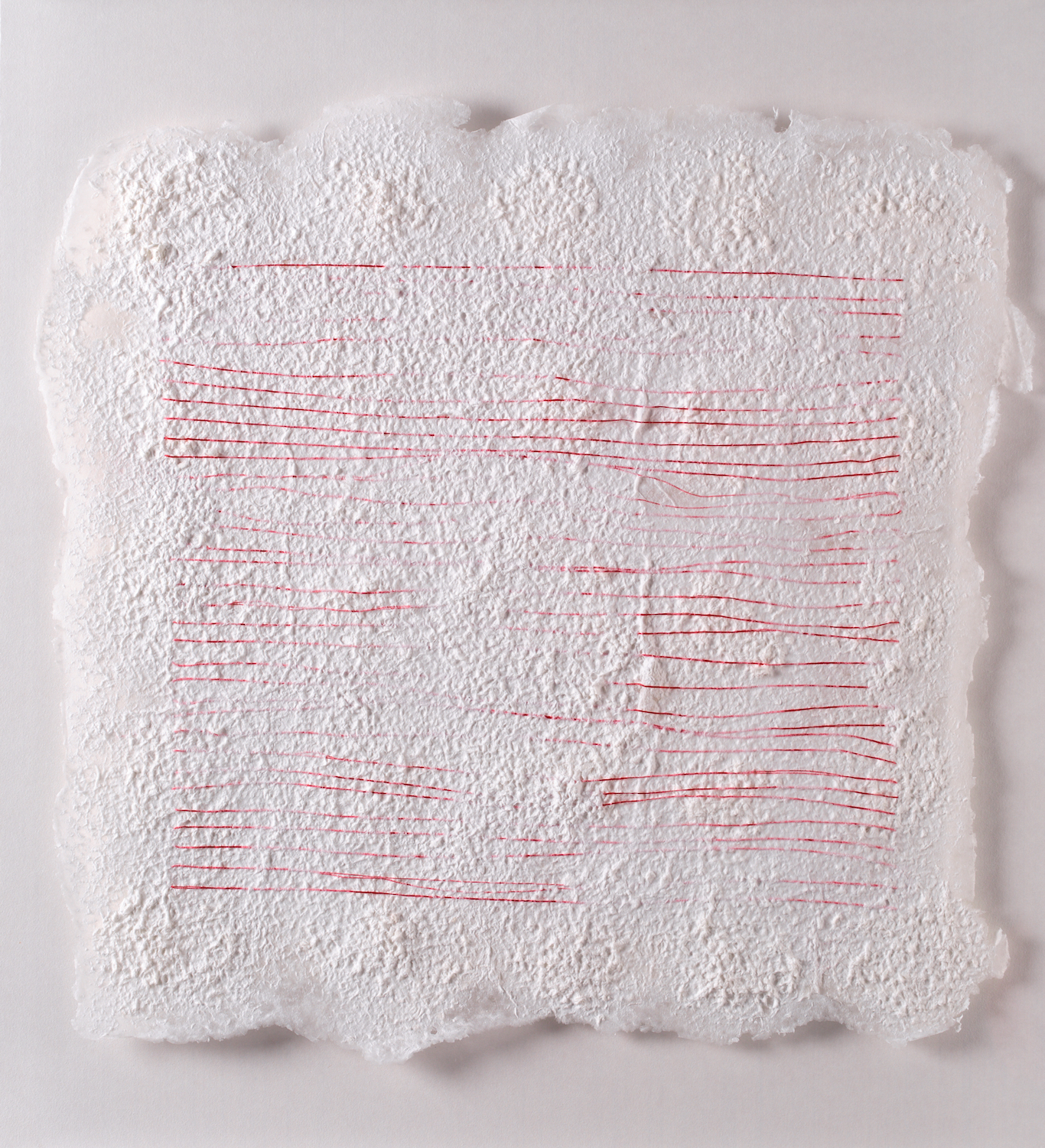
Our routines are changing, Hand-crafted pulp fibres with embedded red thread in acrylic box frame 90*70 cm 2022

Even if we feel we are going nowhere we are living, Hand-crafted pulp fibres with embedded red thread in acrylic box frame, 58*58*5 2022
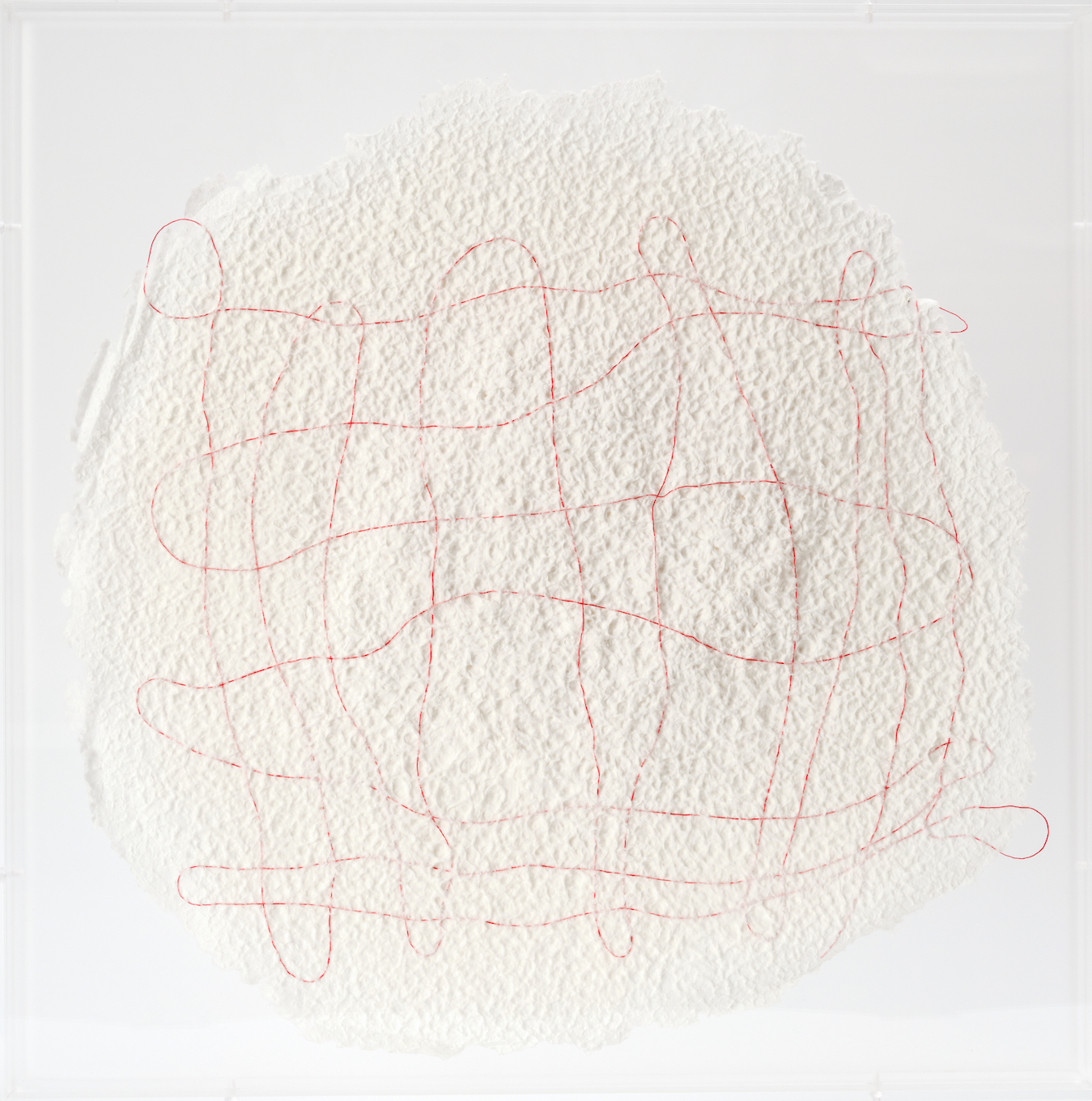
I think I am following you, Hand-crafted pulp fibres with embedded red thread in acrylic box frame, 58*58*5 2022
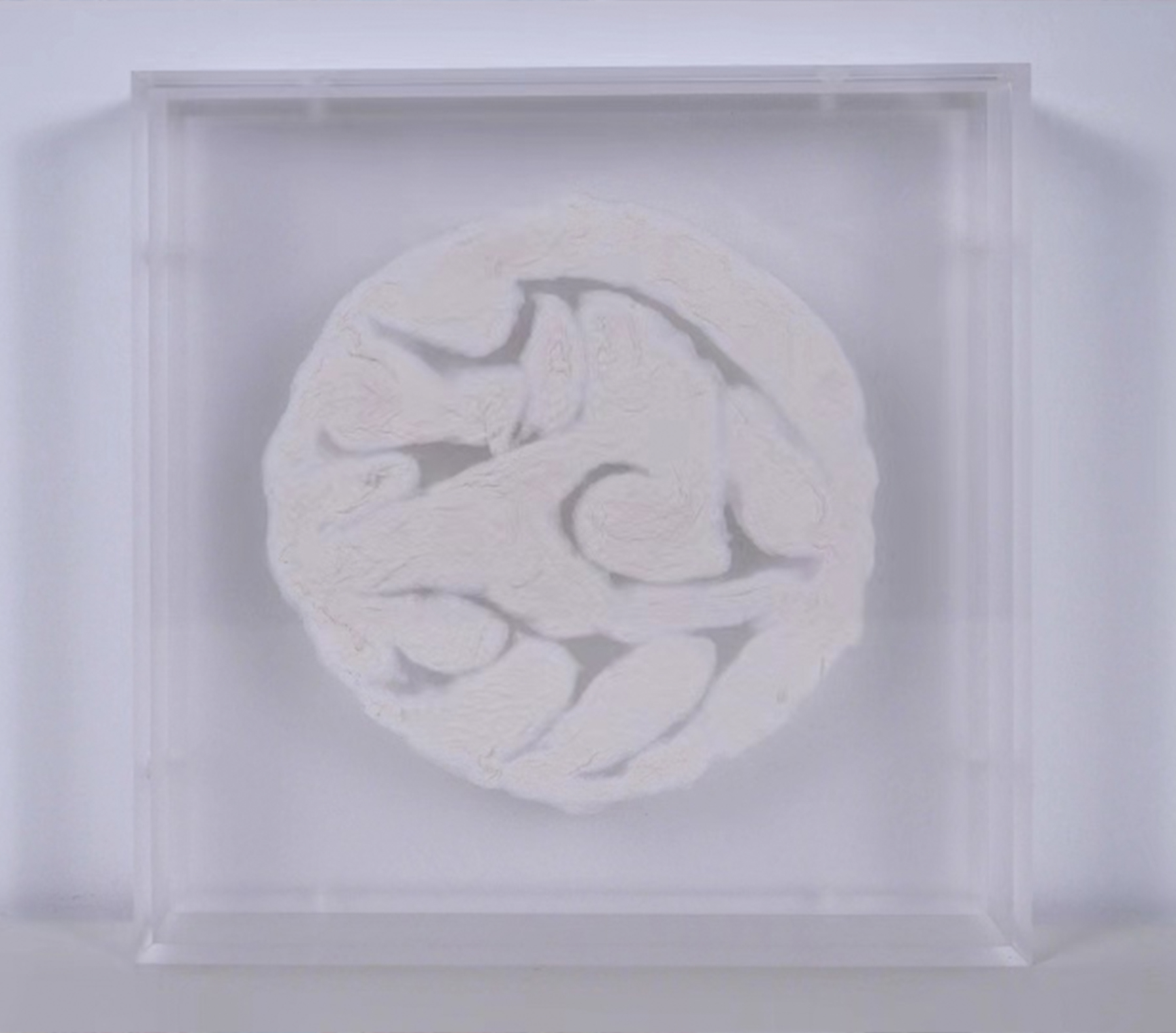
Natural Orbit 4, Hand-crafted paper using pulp fibres and embroidery in acrylic box frame , 16*16*5cm , 2022

Natural Orbit 3, Hand-crafted paper using pulp fibres and embroidery in acrylic box frame , 16*16*5cm , 2022

We used to dream a lot , Hand-crafted paper using pulp fibres and embroidery in acrylic box frame , 45*42*5cm , 2022
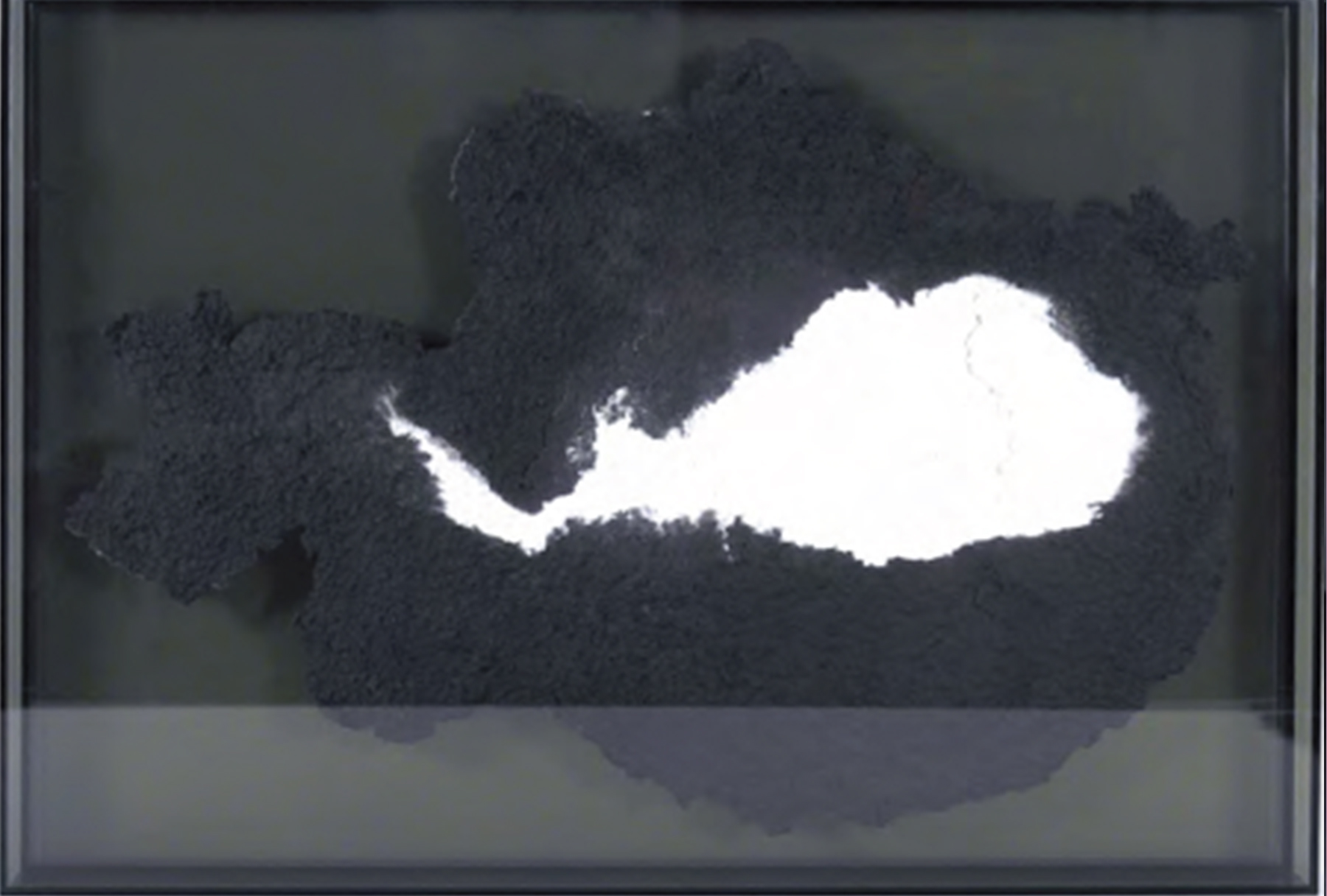
We are running out of time, Hand-crafted paper using pulp fibres soaked in calligraphy ink framed in an black acrylic box frame , 79*55*5cm, 2022

Natural Orbit 2, Hand-crafted paper using pulp fibres and embroidery in acrylic box frame , 16*16*5cm , 2022
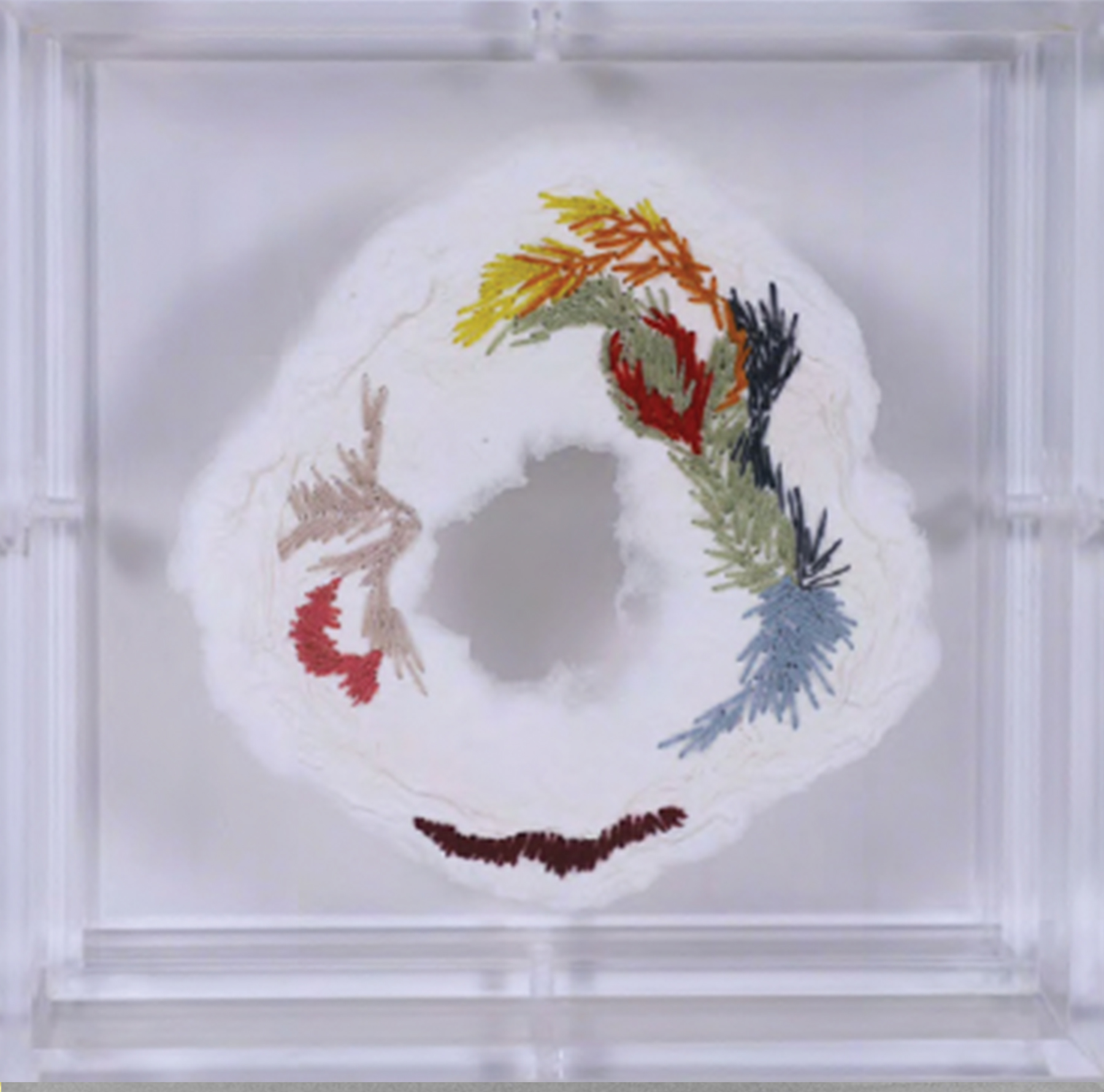
Natural Orbit 1, Hand-crafted paper using pulp fibres and embroidery in acrylic box frame , 16*16*5cm , 2022
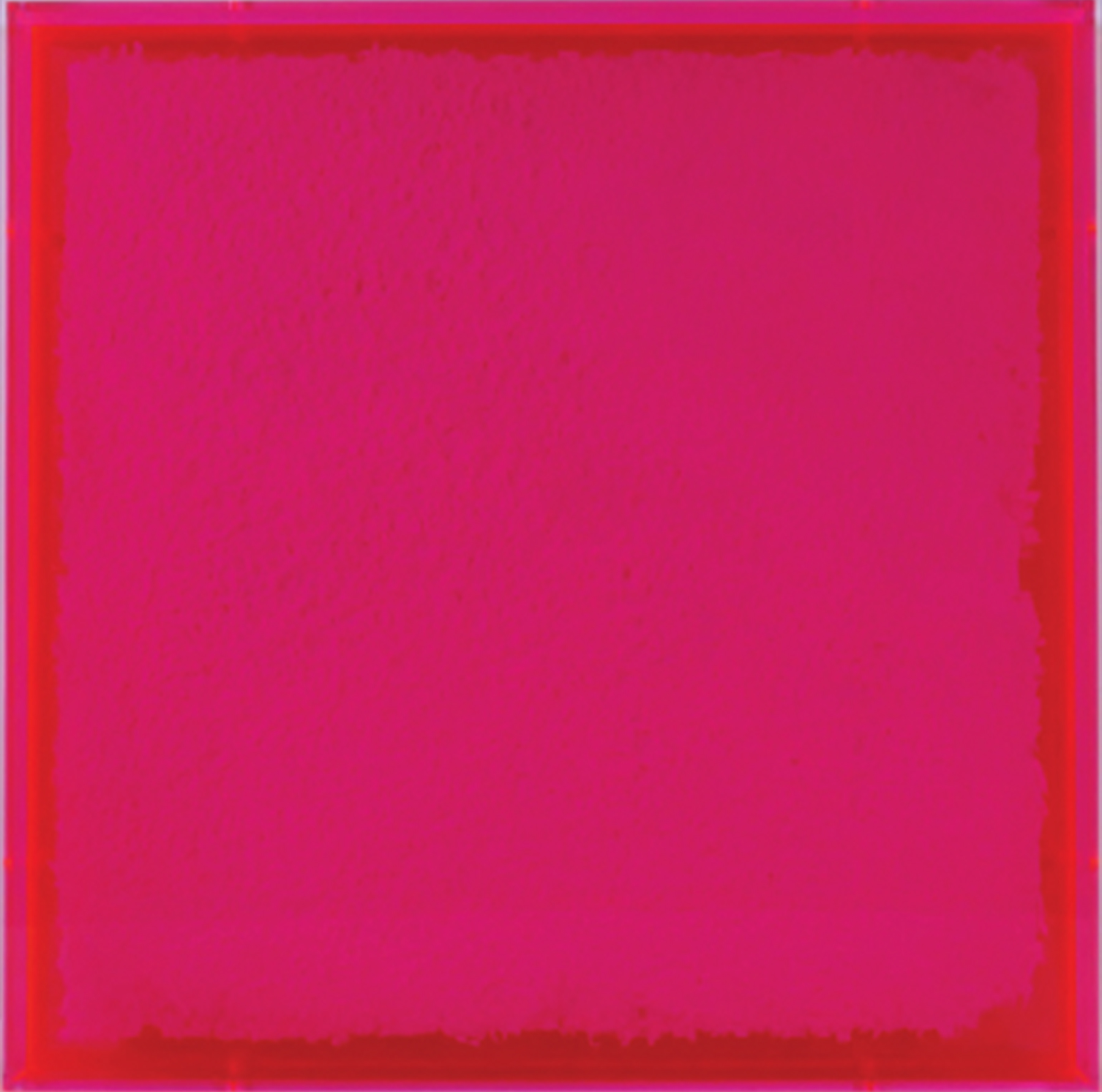
Optimism, Hand-crafted paper using pulp fibres soaked in calligraphy ink framed in an black acrylic box frame , 59*59*5cm, 2022

Fireworks, Embroidered patterns on magnetic movable disks on frame made from linen stretched over a framed metallic surface , 104.7*83.6cm , 2021

The Kite, Embroidered patterns on magnetic movable disks on frame made from linen stretched over a framed metallic surface , 104.7*83.6cm, 2021

Dew, Embroidered patterns on magnetic movable disks on frame made from linen stretched over a framed metallic surface, 123.5*103.6cm , 2021

Refracted Deep Sea , Embroidered patterns on magnetic movable disks on frame made from linen stretched over a framed metallic surface , 83.6*104.7cm, 2021
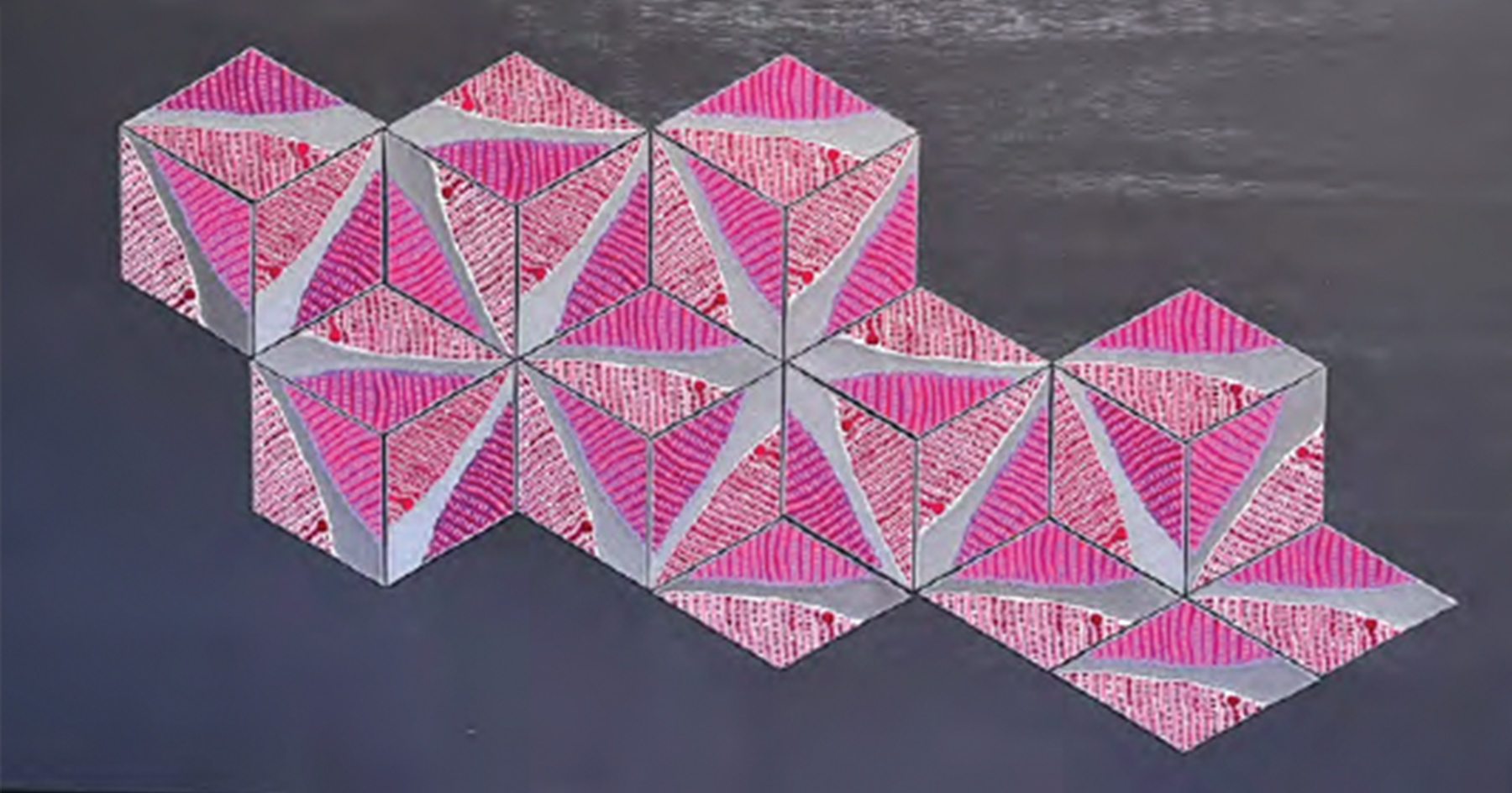
Coral, Embroidered patterns on magnetic movable disks on frame made from linen stretched over a framed metallic surface, 83.6*104.7cm, 2021

Dragon Dance , Embroidered patterns on magnetic movable disks on frame made from linen stretched over a framed metallic surface, 76.4*121.6cm , 2022
“Feel the Power” Group Exhibition by Female Artists
Exhibition Duration: March 11th, 2023 – May 28th, 2023
Artist: Bai Shui, Chen Zhou Ya Yi, KeySook Geum, Lin Fanglu, Sabrina J, Ye Hongxing
Curator: Zirui Zhuang
Venue: HKRI Taikoo Hui
No.288 Shi Men Yi Road, Unit W01, Jingan District, 200002 Shanghai, China
Mon-Sun, 10:00 am -10:00 pm
ABOUT THE EXHIBITION
The Reborn of Goddess
by Zirui Zhuang
Imagine a vast, tumultuous ocean. Its rolling waves carrying a force capable of shaking the very foundations of the earth. Yet within the chaos, there are also moments of tranquility and beauty, as the sunlight reflects off the frothy whitecaps.
Water is a miraculous element, with infinite forms and energies. For women, water is a magical representation, woven into the fabric of Eastern and Western mythology as a vital aspect of goddesses' development, celebrated by poets throughout history. Whether it's Change from the Moon Palace in Chinese mythology or Athena, the goddess of wisdom in Greek mythology, water is a source of power for women.
Water holds a special symbolic significance, showcasing femininity across different cultures and religions. As a source of life and a purifying agent, water is intricately linked to the qualities and experiences of women. Water's spirituality and delicacy serve as the most appropriate metaphor for women's emotions, intuition, and perceptiveness.
“Feel the Power: Group Exhibition by Female Artists" organised by Art+ Shanghai Gallery showcases the works of six female artists from different age groups and cultural backgrounds. The works possess a unique combination of tenderness and strength, like water that is soft and gentle, yet also mighty and vast. Their chosen mediums vary from traditional handcrafts such as handmade paper, embroidery, and
flower arrangement to modern mixed-media and installation art, reflecting their exploration and contemplation of women as a collective.
Artist Bai Shui is the best interpretation of the exploration spirit of women. Her background of living overseas for many years and achievements in finance, crafts, design, and other fields have enabled her to create her own logical universe. She injects more vibrant vitality into art with an unrestricted attitude. This exhibition includes her latest works. The installation piece "Raindrops" is made of optical glass. By magnifying raindrops to an extreme degree, the audience is made to ponder the relationship between humans and the Earth. Raindrops, originally tiny in nature, are transformed into colossal objects on a macroscopic scale, creating a huge impact on human basic cognition. Most of Bai Shui's works possess such qualities. These works have their own aesthetic tones and can also attract the audience's attention at first glance, encouraging them to ponder larger themes beyond daily life. The “the Four Quadrants" series takes inspiration from the four holy beasts in Chinese mythology, combines watercolor painting with artificial intelligence painting techniques. Not only are the images of the four holy beasts reinterpreted, but a future world customs painting coexisting with artificial intelligence is also slowly laid out in front of us. The "Pisces" series is the perfect manifestation of Bai Shui's combination of her understanding of human status, Western and Eastern philosophy and religious studies. The Yin and Yang totems in Taoist classics are integrated into the feast of the heavenly gods in the story of constellation Pisces. The two fish are connected head to tail, and they continue to reincarnate. This series includes three groups of works: Heavenly Water, Earthly Water, and Human Water. Heavenly Water is a space, an infinite universe. Earthly Water is shown like a light cone, in which everyone is connected by a wonderful link. As the artist herself said, "We are like entangled quantum particles, trapped within the speed of light." Human Water illustrates a beating heart and the blood vessels surrounding it. This is the most primitive form of life. Bai Shui uses this group of works to show her respect for life, the earth, and the universe. Rather than saying this is a creation, it is better to say that this is a ritual arranged by the artist. The artist herself acts as the high priestess conducting this ceremony. She awakens the audience, arouses the most primitive awe and reverence for nature of human through her works.
YA YI is a fashion designer, creative director, artist and film-maker. Growing up in Spain, China and USA, YA YI’s artistic inspirations stem from her trilingual and multicultural upbringing that saw her immersed in multiple clashing yet distinct cultures. Her work is embedded in exploring women with multicultural identities and expanding the cross-disciplinary conversation of fashion, performance, film and fine art.
Soon after her graduation from Parsons School of Design and exchange studies at Central Saint Martins, YA YI’s work was featured in multiple media and platforms including Vogue, Dazed, WWD, Nowness, Harper’s Bazaar, Marie Claire, SHOWstudio, and CFDA. In 2022, the designer established her namesake label YA YI in New York City. In May, during AAPI heritage month, YA YI launched her début series named ‘IT IS NOT SPRING, UNTIL ALL FLOWERS BLOSSOM’. Between a fashion collection, documentary film, performance film and artist book, this multi-disciplinary project involves the collaboration of more than 50 Asian and American creatives based in the US. Together, they reinterpret the garment factory space and portray the invisible working hands as a homage to the Asian American immigration history.
YA YI seeks to explore women’s awakening in the long history. While weaving the voices and emotions of female collectives with multi-cultural backgrounds, she uses her theatrical design language to explore the complexity of the identity of Asian immigrant women in her unique and poetic fabric craftsmanship. The showcased works not only exhibit her distinctive design language, but also unveils her textile art which she skillfully combines eastern fabrics with western fringes and lace techniques. Her knitted garments appear delicate yet fragile, as thin as cicada wings, drifting like a faint wisp of smoke under the scorching sun. She applies her years of design experience in the fashion industry with her art creation. Her works exude a Zen realm, pure and ethereal. Her works exude a Zen realm, pure and ethereal, like growing flowers floating within the space. This auto-ethnographic method of creating art becomes YA YI’s self-cultivation practice and a reflection of her interpretation of femininity.
KeySook Geum is a Korean artist, designer, and educator. Currently a professor in the Department of Textile Art and Fashion Design at Hongik University in Seoul, Korea, she has a doctorate in textiles from Ewha Womans University (Seoul, Korea) and completed a post-doctorate fellowship at the University of Minnesota (Minnesota, United States). Having worked in fashion design and costuming, she began working with wire and art sculptures in 1996. Constructing both abstract and figurative forms, KeySook Geum has exhibited extensively in Berlin, Vienna, New York, Chicago, New Orleans, Tokyo, Seoul, Hong Kong and Shanghai. She has been appointed as the Chief Costume Designer during the PyeongChang Winter Olympic Games 2018.
Suspended from near invisible wires or drawing from the walls, there is a sense of weightlessness and quietness to Geum’s sculptures that display a marked femininity and feminism, a mixture of strength and transparency that incorporates the materiality of wire and beads with the ephemeral qualities of light and shadow.
Her works mainly focus on the series of metal wire sculptures. The cold and metallic wires, under her weaving, converge into distinct outlines of the human body. The hardness of metal is transformed into the softness of the human body, the rational arrangement of the lines turned to the final presentation of the emotional image. These diametrically opposed words are cleverly blended together by the artist, like a delicate balance between two ends of a scale. This is just like what Taoism says - yin and yang mutually generate and restrain, mutually depend and transform. Keysook's works present such a process of transformation. This duality is also exactly like women - soft, yet strong.
Lin Fanglu has completed her Master and Bachelor degrees in Artistic Design at the Central Academy of Fine Arts (CAFA) in 2016 and 2012. During her studies, she participated in the exchange program in Karlsruhe University of Art and Design, Germany, and Tokyo University of the Arts in Japan. Upon her come back to China, Fanglu decided to experience first-hand the traditions and folkways of Chinese ethnic minorities and researched in-depth the disappearing techniques of tie-dyeing from the Bai women community in Yunnan and the Dong traditional hand-woven cloth-bright cloth from Guizhou.
Numerous visits to the villages have resulted in new “She” series that have participated in several exhibitions in China and abroad. The new series inspired by Dong Minority have been exhibited at Design Miami/ Podium, Shanghai November 2021. Her work “Iron Drum Sofa” has been collected by London Zero-Carbon Pavilion during the Shanghai World Expo in 2010. In 2016 she won both the Young Designer of the Year and the Innovative Brand of the Year at Beijing’s China Building Decoration Association Awards In 2020 she became one of the 30 finalists of the prestigious LOEWE FOUNDATION CRAFT PRIZE among thousands of applicants from around the world. In 2021 she finally won the first prize of LOEWE FOUNDATION CRAFT PRIZE. The winning work is now part of the permanent collection of Musée des Arts Decoratifs in Paris.
Lin Fanglu, as a Chinese female weaving artist, re-examines and plans the traditional techniques related to women. In her hands, fabrics and threads are reorganized and intertwined to create exquisitely sculpted outlines. Lin Fanglu's inspiration mainly comes from the Bai ethnic group located in Yunnan. She has taken a part of the numerous crafts of Bai women weavers, upgraded it and brought it back to life. This traditional technique has been passed down for thousands of years and has been revived in Lin Fanglu's hands. Her sculptures resemble blooming flowers, lush forests, underwater landscapes, or alien creatures. It is her imaginative power and practical creativity that have successfully brought this technique of "za hua" (flower tying) to the public eye and international stage. These ordinary fabrics seem to come to life in her hands, extending gracefully like the female body. Through her artwork, she also conveys the current dilemma of women - those rural hard-working women who are still neglected and forgotten in the society. But with the expression of female strength in her works, she believes that one day, women will awaken again and be remembered by the world.
Sabrina J Sabrina was born in Reunion Island but grew up in France. She studied Applied Arts in Duperré School and Boulle School in Paris and has since lived in Paris, London, Ho Chi Minh City and now Shanghai for the last 9 years.
Throughout her career she’s been deeply involved in art, interior design, product design and fashion as a Creative Director. As her roles have evolved, she has worked with fine craftsmen and women across a range of different materials with a keen interest in sourcing materials and artefacts steeped in cultures from around the world. The one constant has been her fascination with weaving styles together, combining different materials and textures, mixing cultural influences, whether this be through design, fashion or art. Material associations, textures, and hybrid cultural references have been part of her creative identity as both a designer and an artist.
Her inspiration comes not only from the texture of the material but also from its history and cultural background. Sabrina's control over handmade paper is reflected in its texture. The lines and patterns on the paper, some flowing like a stream, others shifting like valleys and rivers, resemble a rainforest planted by her. Her thoughts become a mist that permeates the artwork, an essential part of her forest in the rain. It is the combination of her imagination and creativity that has successfully brought flower arrangement into the public's eye and onto the international stage.
Ye Hongxing completing her Master’s degree in Printmaking Department of the Central Academy of Fine Art CAFA, Beijing. Her unique aesthetic has earned her popular acclaim worldwide. She has collaborated with designer Christian Louboutin, and is widely collected by high-profile figures within China and abroad. Ye Hongxing has exhibited at galleries and museums throughout China, Europe, and the United States, and has been shown internationally at fairs including Paris Art Fair, London Art Fair, Art Central (Hong Kong), Art Stage Singapore, India Art Fair (New Delhi), Art Basel (Miami), SH Contemporary Art Fair (Shanghai), Art Beijing Contemporary Art Fair (Beijing), Art Taipei, Art Cologne, Scope (Basel, New York), PULSE (New York), Art Asia (Miami), where her installation was labeled one of the fair’s highlights.
She is the recipient of several awards including the Dragon Air Emerging Chinese Artist Award in 2006, selected by the Director of Art Cologne and curator of the Asian Art Museum.
She has been featured as one of the influential female artists in the Beijing fashion magazine SKP in the issue “Woman of the Future” 2021.
Ye Hongxing began working with stickers in 2009. With these works, a new sense of production was created. The foundational layer of her work is a painting, while the conception of her work allows for spur of the moment changes during the sticker placement process. The production is not merely the physical embodiment of the idea, but an inseparable part of the creative process itself, with the fitting together of stickers and matching of colours, a form of meditation.
At first glance, Ye Hongxing's work appears to be a collage of Ukiyo-e prints. However, upon closer inspection, one can be awestruck by the infinite details she incorporates. Each curve and twist in her works, as stated in the 18th chapter of the Diamond Sutra, "one flower, one world," is a seemingly endless vortex of energy she creates using various media. Ye's grandiose vision and precise control over details in her artwork give it a structuralist's coldness. She is like an iceberg drifting in the North Atlantic, the coldest and loneliest form of water. You can infer the grandeur of the mountains hidden deep in the sea from the tiny peak of the iceberg exposed on the surface.
The six artists participating in this exhibition each interpret the concept of womanhood from their own field. Strength, complexity, power, softness, and many more words are pieced together to form a simple outline of a collective. The metaphor of women being like water has existed for thousands of years, but in the 19th century, this metaphor lost its original divinity and even became a derogatory term. However, with the efforts of generation after generation, stereotypes of women have gradually been dismantled just like they should. Women, like the water, like the sea, nurture life and complete life. In this new era, they will be reborn as Venus, emerging from a giant shell, standing above the sea and gazing towards a beautiful new world.